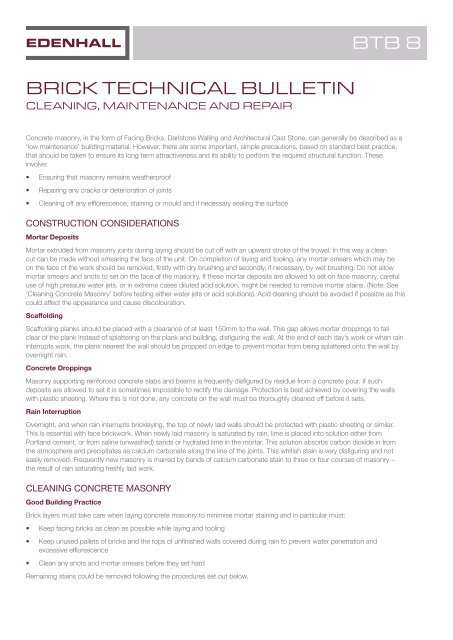You also want an ePaper? Increase the reach of your titles
YUMPU automatically turns print PDFs into web optimized ePapers that Google loves.
BRICK TECHNICAL BULLETIN<br />
CLEANING, MAINTENANCE AND REPAIR<br />
BTB 8<br />
Concrete masonry, in the form of Facing Bricks, Darlstone Walling and Architectural Cast Stone, can generally be described as a<br />
‘low maintenance’ building material. However, there are some important, simple precautions, based on standard best practice,<br />
that should be taken to ensure its long term attractiveness and its ability to perform the required structural function. These<br />
involve:<br />
• Ensuring that masonry remains weatherproof<br />
• Repairing any cracks or deterioration of joints<br />
• Cleaning off any efflorescence, staining or mould and if necessary sealing the surface<br />
CONSTRUCTION CONSIDERATIONS<br />
Mortar Deposits<br />
Mortar extruded from masonry joints during laying should be cut off with an upward stroke of the trowel. In this way a clean<br />
cut can be made without smearing the face of the unit. On completion of laying and tooling, any mortar smears which may be<br />
on the face of the work should be removed, firstly with dry brushing and secondly, if necessary, by wet brushing. Do not allow<br />
mortar smears and snots to set on the face of the masonry. If these mortar deposits are allowed to set on face masonry, careful<br />
use of high pressure water jets, or in extreme cases diluted acid solution, might be needed to remove mortar stains. (Note: See<br />
‘Cleaning Concrete Masonry’ before testing either water jets or acid solutions). Acid cleaning should be avoided if possible as this<br />
could affect the appearance and cause discolouration.<br />
Scaffolding<br />
Scaffolding planks should be placed with a clearance of at least 150mm to the wall. This gap allows mortar droppings to fall<br />
clear of the plank instead of splattering on the plank and building, disfiguring the wall. At the end of each day’s work or when rain<br />
interrupts work, the plank nearest the wall should be propped on edge to prevent mortar from being splattered onto the wall by<br />
overnight rain.<br />
Concrete Droppings<br />
Masonry supporting reinforced concrete slabs and beams is frequently disfigured by residue from a concrete pour. If such<br />
deposits are allowed to set it is sometimes impossible to rectify the damage. Protection is best achieved by covering the walls<br />
with plastic sheeting. Where this is not done, any concrete on the wall must be thoroughly cleaned off before it sets.<br />
Rain Interruption<br />
Overnight, and when rain interrupts bricklaying, the top of newly laid walls should be protected with plastic sheeting or similar.<br />
This is essential with face brickwork. When newly laid masonry is saturated by rain, lime is placed into solution either from<br />
Portland cement, or from saline (unwashed) sands or hydrated lime in the mortar. This solution absorbs carbon dioxide in from<br />
the atmosphere and precipitates as calcium carbonate along the line of the joints. This whitish stain is very disfiguring and not<br />
easily removed. Frequently new masonry is marred by bands of calcium carbonate stain to three or four courses of masonry –<br />
the result of rain saturating freshly laid work.<br />
CLEANING CONCRETE MASONRY<br />
Good Building Practice<br />
Brick layers must take care when laying concrete masonry to minimise mortar staining and in particular must:<br />
• Keep facing bricks as clean as possible while laying and tooling<br />
• Keep unused pallets of bricks and the tops of unfinished walls covered during rain to prevent water penetration and<br />
excessive efflorescence<br />
• Clean any snots and mortar smears before they set hard<br />
Remaining stains could be removed following the procedures set out below.







